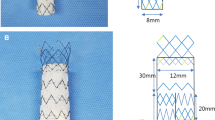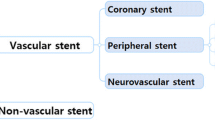Abstract
Introduction
To access the effect of actual metal coverage rate (MCR) on neointimal growth at covered side branch ostium and stented artery after implantation of a flow diversion device.
Methods
Flow diverters (FDs) were implanted into abdominal aortas of 20 New Zealand rabbits. Four weeks and three months after FD implantation, the patency of side branches covered by the devices was assessed by angiography. The animals were sacrificed after angiography at 3 months postsurgery. The local actual MCR was measured under microscope and calculated. The extent of neointimal coverage at the ostia of branches and the neointima within the stent were examined by histology and scanning electron microscopy.
Results
No side branch occlusion was noted, either immediately after implantation or at follow-ups. At 3 months after implantation, the intimal coverage of branch ostia caused by a 30–40% MCR was not significantly different from that caused by an MCR ≤ 30% (p = 0.792), but it was significantly lower than that caused by an MCR ≥ 40% (p = 0.021). Neointimal thickness in the stented abdominal aorta was positively correlated to MCR (r = 0.523, p = 0.001). The neointima was composed predominantly of smooth muscle cells and collagen fibers.
Conclusion
The actual MCR exhibited remarkable differences once FD was implanted in vivo. Significantly more intimal coverage at the side branch ostia could be induced when MCR was ≥40%. The neointimal thickness within the stent was positively correlated to device MCR.





Similar content being viewed by others
References
Ahlhelm F, Roth C, Kaufmann R, Schulte-Altedorneburg G, Romeike BF, Reith W (2007) Treatment of wide-necked intracranial aneurysms with a novel self-expanding two-zonal endovascular stent device. Neuroradiology 49:1023–1028
Augsburger L, Farhat M, Reymond P, Fonck E, Kulcsar Z, Stergiopulos N, Rufenacht DA (2009) Effect of flow diverter porosity on intraaneurysmal blood flow. Klin Neuroradiol 19:204–214
Aurboonyawat T, Blanc R, Schmidt P, Piotin M, Spelle L, Nakib A, Moret J (2011) An in vitro study of silk stent morphology. Neuroradiology 53:659–667
Aurboonyawat T, Schmidt PJ, Piotin M, Blanc R, Spelle L, Moret J (2011) A study of the first-generation pipeline embolization device morphology using intraoperative angiographic computed tomography (ACT). Neuroradiology 53:23–30
Fiorella D, Kelly ME, Albuquerque FC, Nelson PK (2009) Curative reconstruction of a giant midbasilar trunk aneurysm with the pipeline embolization device. Neurosurgery 64:212–217
Fiorella D, Woo HH, Albuquerque FC, Nelson PK (2008) Definitive reconstruction of circumferential, fusiform intracranial aneurysms with the pipeline embolization device. Neurosurgery 62:1115–1120
Ionita CN, Dohatcu A, Sinelnikov A, Sherman J, Keleshis C, Paciorek AM, Hoffmann KR, Bednarek DR, Rudin S (2009) Angiographic analysis of animal model aneurysms treated with novel polyurethane asymmetric vascular stent (P-AVS): feasibility study. Proc Soc Photo Opt Instrum Eng 7262:72621H72621–72621H72610
Ionita CN, Paciorek AM, Dohatcu A, Hoffmann KR, Bednarek DR, Kolega J, Levy EI, Hopkins LN, Rudin S, Mocco JD (2009) The asymmetric vascular stent: efficacy in a rabbit aneurysm model. Stroke 40:959–965
Ionita CN, Paciorek AM, Hoffmann KR, Bednarek DR, Yamamoto J, Kolega J, Levy EI, Hopkins LN, Rudin S, Mocco J (2008) Asymmetric vascular stent: feasibility study of a new low-porosity patch-containing stent. Stroke 39:2105–2113
Kallmes DF, Ding YH, Dai D, Kadirvel R, Lewis DA, Cloft HJ (2007) A new endoluminal, flow-disrupting device for treatment of saccular aneurysms. Stroke 38:2346–2352
Kallmes DF, Ding YH, Dai D, Kadirvel R, Lewis DA, Cloft HJ (2009) A second-generation, endoluminal, flow-disrupting device for treatment of saccular aneurysms. AJNR Am J Neuroradiol 30:1153–1158
Kim M, Taulbee DB, Tremmel M, Meng H (2008) Comparison of two stents in modifying cerebral aneurysm hemodynamics. Ann Biomed Eng 36:726–741
Kulcsar Z, Ernemann U, Wetzel SG, Bock A, Goericke S, Panagiotopoulos V, Forsting M, Ruefenacht DA, Wanke I (2010) High-profile flow diverter (silk) implantation in the basilar artery: efficacy in the treatment of aneurysms and the role of the perforators. Stroke 41:1690–1696
Kulcsar Z, Wetzel SG, Augsburger L, Gruber A, Wanke I, Andre Rufenacht D, Sadasivan C, Cesar L, Seong J, Rakian A, Hao Q, Tio FO, Wakhloo AK, Lieber BB, Fujimura N, Ohta M, Abdo G, Ylmaz H, Lovblad KO, Rufenacht DA (2009) Effect of flow diversion treatment on very small ruptured aneurysms. Neurosurgery 67:789–793
Lieber BB, Livescu V, Hopkins LN, Wakhloo AK (2002) Particle image velocimetry assessment of stent design influence on intra-aneurysmal flow. Ann Biomed Eng 30:768–777
Lieber BB, Sadasivan C (2010) Endoluminal scaffolds for vascular reconstruction and exclusion of aneurysms from the cerebral circulation. Stroke 41(10 Suppl):S21–25
Lieber BB, Stancampiano AP, Wakhloo AK (1997) Alteration of hemodynamics in aneurysm models by stenting: influence of stent porosity. Ann Biomed Eng 25:460–469
Liou TM, Li YC (2008) Effects of stent porosity on hemodynamics in a sidewall aneurysm model. J Biomech 41:1174–1183
Liou TM, Li YC, Wang TC (2008) Hemodynamics altered by placing helix stents in an aneurysm at a 45 degrees angle to the curved vessel. Phys Med Biol 53:3763–3776
Lubicz B, Collignon L, Raphaeli G, Pruvo JP, Bruneau M, De Witte O, Leclerc X (2010) Flow-diverter stent for the endovascular treatment of intracranial aneurysms: a prospective study in 29 patients with 34 aneurysms. Stroke 41:2247–2253
Lylyk P, Miranda C, Ceratto R, Ferrario A, Scrivano E, Luna HR, Berez AL, Tran Q, Nelson PK, Fiorella D (2009) Curative endovascular reconstruction of cerebral aneurysms with the pipeline embolization device: the Buenos Aires experience. Neurosurgery 64:632–642
Sadasivan C, Cesar L, Seong J, Rakian A, Hao Q, Tio FO, Wakhloo AK, Lieber BB (2009) An original flow diversion device for the treatment of intracranial aneurysms: evaluation in the rabbit elastase-induced model. Stroke 40:952–958
Sadasivan C, Cesar L, Seong J, Wakhloo AK, Lieber BB (2009) Treatment of rabbit elastase-induced aneurysm models by flow diverters: development of quantifiable indexes of device performance using digital subtraction angiography. IEEE Trans Med Imaging 28:1117–1125
Sadasivan C, Lieber BB, Cesar L, Miskolczi L, Seong J, Wakhloo AK (2006) Angiographic assessment of the performance of flow divertors to treat cerebral aneurysms. Conf Proc IEEE Eng Med Biol Soc 1:3210–3213
Seong J, Wakhloo AK, Lieber BB (2007) In vitro evaluation of flow divertors in an elastase-induced saccular aneurysm model in rabbit. J Biomech Eng 129:863–872
Szikora I, Berentei Z, Kulcsar Z, Marosfoi M, Vajda ZS, Lee W, Berez A, Nelson PK (2010) Treatment of intracranial aneurysms by functional reconstruction of the parent artery: the Budapest experience with the pipeline embolization device. AJNR Am J Neuroradiol 31:1139–1147
Szikora I, Nelson PK, Berentei Z, Kulcsar Z, Marosfoi M, Berez A (2008) The potential of flow modification in the treatment of intracranial aneurysms. Interv Neuroradiol 14(Suppl 1):77–80
van Rooij WJ, Sluzewski M (2010) Perforator infarction after placement of a pipeline flow-diverting stent for an unruptured A1 aneurysm. AJNR Am J Neuroradiol 31:E43–E44
Molyneux AJ, Kerr RS, Birks J, Ramzi N, Yarnold J, Sneade M, Rischmiller J (2009) Risk of recurrent subarachnoid haemorrhage, death, or dependence and standardised mortality ratios after clipping or coiling of an intracranial aneurysm in the international subarachnoid aneurysm trial (ISAT): long-term follow-up. Lancet Neurol 8:427–433
Molyneux AJ, Kerr RS, Yu LM, Clarke M, Sneade M, Yarnold JA, Sandercock P (2005) International subarachnoid aneurysm trial (ISAT) of neurosurgical clipping versus endovascular coiling in 2143 patients with ruptured intracranial aneurysms: a randomised comparison of effects on survival, dependency, seizures, rebleeding, subgroups, and aneurysm occlusion. Lancet 366:809–817
Rhee K, Han MH, Cha SH (2002) Changes of flow characteristics by stenting in aneurysm models: influence of aneurysm geometry and stent porosity. Ann Biomed Eng 30:894–904
Komatsu R, Ueda M, Naruko T, Kojima A, Becker AE (1998) Neointimal tissue response at sites of coronary stenting in humans: macroscopic, histological, and immunohistochemical analyses. Circulation 98:224–233
Edelman ER, Rogers C (1998) Pathobiologic responses to stenting. Am J Cardiol 81:4E–6E
Acknowledgments
This work was supported by the National Natural Science Foundation of China (30973102, 30901556) and Rising-Star Program of Shanghai Science and Technology Committee (grant no. 11QA1408400). We gratefully thank MicroPort Medical (Shanghai) for the free flow-diverting stents.
Conflict of interest
We declare that we have no conflict of interest.
Author information
Authors and Affiliations
Corresponding author
Additional information
Dr. Kuizhong Wang and Bo Hong are co-first authors.
Rights and permissions
About this article
Cite this article
Hong, B., Wang, K., Huang, Q. et al. Effects of metal coverage rate of flow diversion device on neointimal growth at side branch ostium and stented artery: an animal experiment in rabbit abdominal aorta. Neuroradiology 54, 849–855 (2012). https://doi.org/10.1007/s00234-011-0984-6
Received:
Accepted:
Published:
Issue Date:
DOI: https://doi.org/10.1007/s00234-011-0984-6




